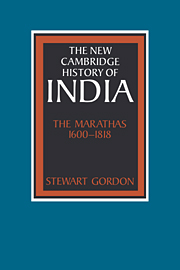Book contents
- Frontmatter
- Introduction: historiography and bibliography
- 1 The Geopolitics of Maharashtra
- 2 Marathas and the Deccan Sultanates
- 3 Shivaji (1630–80) and the Maratha polity
- 4 Responses to family invasion (1680–1719)
- 5 Baji Rao I's northern expansion (1720–1740)
- 6 Conquest to administration (1740–1760)
- 7 Centripetal forces (1760–1803)
- Index
- THE NEW CAMBRIDGE HISTORY OF INDIA
- References
5 - Baji Rao I's northern expansion (1720–1740)
Published online by Cambridge University Press: 28 March 2008
- Frontmatter
- Introduction: historiography and bibliography
- 1 The Geopolitics of Maharashtra
- 2 Marathas and the Deccan Sultanates
- 3 Shivaji (1630–80) and the Maratha polity
- 4 Responses to family invasion (1680–1719)
- 5 Baji Rao I's northern expansion (1720–1740)
- 6 Conquest to administration (1740–1760)
- 7 Centripetal forces (1760–1803)
- Index
- THE NEW CAMBRIDGE HISTORY OF INDIA
- References
Summary
Balaji Vishwanath died in 1720. Against the objections of other ministers, Shahu appointed Balaji's son, Bijirao. Here we meet, after Shivaji, the most charismatic and dynamic leader in Maratha history. He was only twenty years old and already had a reputation for rapid decisions and a passion for military adventure. Bajirao had been on the expedition to Delhi in 1719, and was convinced that the Mughal Empire was breaking up and could not resist a Maratha drive to the north into Malwa and beyond. This was the major theme of the next twenty years of his ceaseless military and administrative activity.
This judgement by Bajirao was quite correct. Let us consider the various regions of the Mughal Empire, starting in the north and working south. Ever since his appointment to the Punjab in 1713, Abdul Samad Khan had sent little information to Delhi beyond the yearly tribute. By the time his son succeeded him in 1726, the Punjab was, functionally, an independent, tribute-paying state (with its own problems with the Sikhs). Awadh followed the same course. Sagdat Khan had been appointed governor in 1722, and independently removed mansabdars and changed jagirs. Four years later, the attempt to remove him resulted in his taking possession of Awadh. Thereafter, the province paid some tribute, but there was no Mughal authority inside it. In 1727 in Bengal, the son of Murshid Quli Khan succeeded to his father's governorship, and the province became functionally independent. The Rajput states, always internally autonomous, expanded in the 1720s.
- Type
- Chapter
- Information
- The Marathas 1600–1818 , pp. 114 - 131Publisher: Cambridge University PressPrint publication year: 1993

